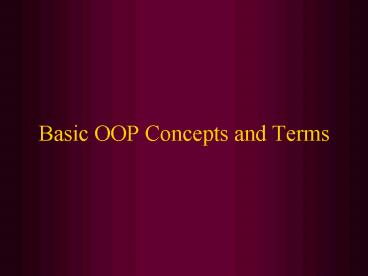Basic OOP Concepts and Terms - PowerPoint PPT Presentation
1 / 23
Title:
Basic OOP Concepts and Terms
Description:
Basic OOP Concepts and Terms In this class, we will cover: Objects and examples of different object types Classes and how they relate to objects Object attributes and ... – PowerPoint PPT presentation
Number of Views:690
Avg rating:3.0/5.0
Title: Basic OOP Concepts and Terms
1
Basic OOP Concepts and Terms
2
In this class, we will cover
- Objects and examples of different object types
- Classes and how they relate to objects
- Object attributes and methods
- Object interactions and messages
- Encapsulation and information hiding
- Inheritence and polymorphism
- The three-tier architecture design
- An introduction to UML
3
(No Transcript)
4
Objects
- Most basic component of OO design. Objects are
designed to do a small, specific piece of work. - Objects represent the various components of a
business system
5
Examples of Different Object Types
- GUI objects
- objects that make up the user interface
- e.g. buttons, labels, windows, etc.
- Problem Domain objects
- Objects that represent a business application
- A problem domain is the scope of what the system
to be built will solve. It is the business
application. - e.g. An order-entry system A payroll
system A student system
6
Sample Problem Domain
Company ABC needs to implement an order-entry
system that takes orders from customers for a
variety of products. What are the objects in
this problem domain? Hint Objects are usually
described as nouns.
7
Possible Objects for this Problem Domain
Customer Order Product
8
Classes and Objects
- Classes
- Define what all objects of the class represent
- It is like a blueprint. It describes what the
objects look like - They are a way for programs to model the real
world - Objects
- Are the instances of the class
9
(No Transcript)
10
Object Attributes and Methods
- Classes contain two things
- Fields (attributes, data members, class
variables) - Data items that differentiate one object of the
class from another. e.g. employee name, student
number - Characteristics of an object that have values
- What are some possible attributes for the
customer object? - Methods (behaviors)
- Named, self-contained blocks of code that
typically operate on the fields - Describe what an object can do
- Can be thought of as the verbs in a problem
domain - What are some possible methods for the customer
object?
11
(No Transcript)
12
(No Transcript)
13
Object Interactions and Messages
- Objects interact with other objects in a variety
of relationships - e.g. one-to-one, one-to-many
- Messages
- The means by which objects interact
- Example
- User initiates interaction via messages to GUI
objects - GUI objects interact with problem domain objects
via messages - Problem domain objects interact with each other
and GUI objects via messages - GUI objects respond to user via messages
14
(No Transcript)
15
(No Transcript)
16
Encapsulation and Information Hiding
- Encapsulation
- Objects have attributes and methods combined into
one unit - Information Hiding
- Hiding the internal structure of objects,
protecting them from corruption - Identity
- Unique reference for each object
- Persistent objects
- Defined as available for use over time
17
Inheritance and Polymorphism
- Inheritance
- One class of objects takes on characteristics of
another class and extends them - Superclass ? subclass
- Generalization/specialization hierarchy
- Also called an inheritance hierarchy
- Result of extending class into more specific
subclasses - This is an important concept!!
18
(No Transcript)
19
Inheritance and Polymorphism
- Polymorphism
- literally means many forms
- in Java means using the same message (or method
name) with different classes - different objects can respond in their own way to
the same message - e.g. toString()
20
(No Transcript)
21
Learning OO Development
- Introducing Three-Tier Design
- Objects that interact in OO system are separated
into three categories of classes - Problem domain classes
- Specific to a particular business application
- GUI classes
- Define objects that make up the UI to the
application - Data access classes
- Work with DBMS to store/retrieve object
information
22
Unified Modeling Language (UML)
- Standard OOAD modeling notation
- Uses model-driven approach
- Enables creation of graphical models of the
system requirements and system design - Components include
- Class diagrams
- Use Case diagrams
- Sequence diagrams
- Statecharts
23
(No Transcript)































